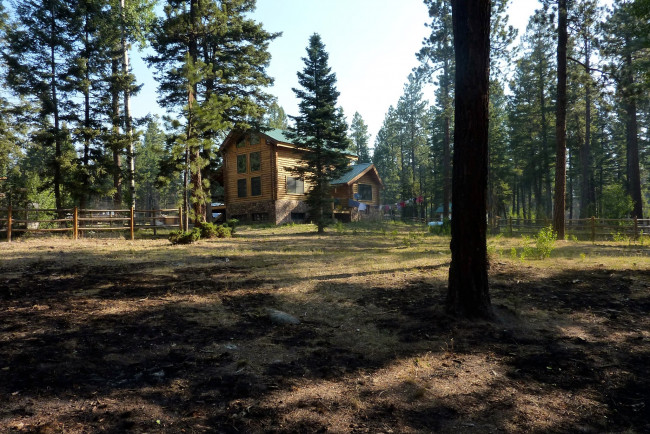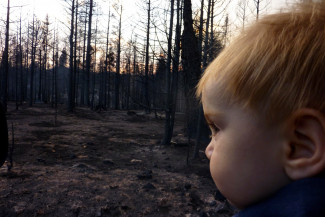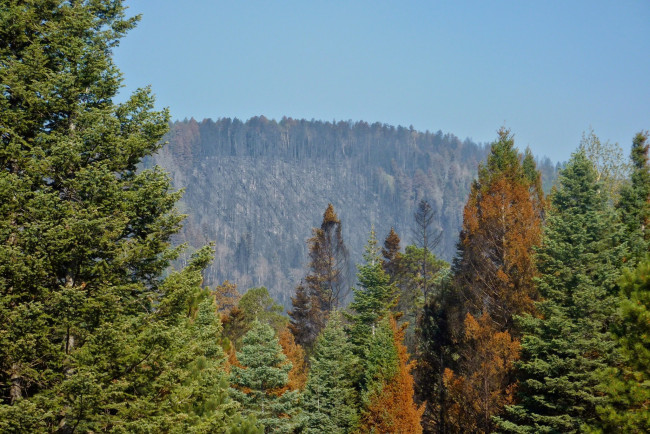By Liz Bailey
Sarah DeMay is a fire professional and land steward whose experience with wildland fire, both personally and professionally, gives her a unique perspective and motivation to be a resource for other landowners in New Mexico.
Sarah’s relationship with forests began at a young age as she grew up playing in the woods of rural Oregon. After graduating college with a degree in biology, Sarah moved to New Mexico for a six-month internship working with the Fire Ecology program at Bandelier National Monument. She stayed on as a crew leader at Bandelier, and thus began her crash course into the world of wildland fire and fire management.
Sarah met her husband, Sam, while working on fire mitigation efforts on his inholding property within Bandelier National Monument, where they have since raised their two children. Sarah left the National Park Service in 2010 to focus on her family and land stewardship. In 2011, the Las Conchas fire burned through their community in Bandelier, decimating the forest in which they lived and further shaping Sarah’s relationship with land stewardship.
Sarah and Sam have found it rewarding to watch the land recover from fire, but they are also preparing for the future on a more water-secure property near Tierra Amarilla, NM, working to reduce wildfire risk on their property and ensure the land’s survival for their children.
What first interested you in forestry and fire?
I grew up outside of a small town in rural Oregon. I spent a lot of time outside and I knew I wanted to work in the woods. About a year after I graduated from college, I got an internship at Bandelier with the Fire Effects Monitoring program and drove my old rickety car to New Mexico with no idea what I would find. We were in the field all the time, it was fantastic. I got to travel around the state and working with awesome people and constantly learning. I didn’t really get into fire until the next year when they gave me a permanent job leading the crew. I took the 130/190 basic wildland fire class the next spring. That was the year of the Cerro Grande fire. It started out as a prescribed burn within Bandelier National Monument and progressed into a major, catastrophic, wildfire that burned over 200 homes. The Cerro Grande Fire was my second prescribed fire and first wildfire.
What was it like for you, being so new to the field of fire and having such a catastrophic fire event happen? How did that shape your perception of the field?
It was a crash course; my introduction to fire was less gradual than it is for many. Nobody knew what that fire was going to do, it was the first fire where we realized that fires were no longer doing what they had done in the past. The fire behavior we were seeing was new, so everyone was learning. Everything was changing rapidly as far as how the fires were burning and what people were doing about it, as well as how organizations were adapting to deal with this brave new world of mega, catastrophic fires. We had to figure out how to deal with them—not only how to fight fire, but what to do for fuels management and mitigation. There was suddenly more money for fuels work and monitoring. It was exciting and I liked that too.
Can you tell me more about your experiences working in fire?
While working for the National Parks Service [1999-2010], I gradually transitioned from fire ecology to fire suppression and eventually ended up working on the local Helitack crew, Santa Fe Helitack. This presented new challenges including lots of travel and commitment. In 2010, I had a baby and I quit my job, which was a big deal to me and a big change of pace. I went from supervising a Helitack crew and fighting fire with all these young, single, hardcore firefighters to being a mom. I had to make new friends and I was at home with a baby. I also had all this time to be outside in a way I hadn’t been for quite a while. I got to just go hiking in sandals and shorts. I had time to look at things again and sit in the grass and watch the birds, garden, all these things I had kind of been missing out on. And then shortly after that [summer of 2011], the Las Conchas Fire happened and here I was on the other side of the fence. I was no longer in the helicopter looking at the fire thinking about how to deal with it, telling people to evacuate – I was the one being evacuated, and I was the one whose property was burning. That was eye-opening, understanding what private landowners actually go through when a wildfire like that burns through their land, what it’s like to be evacuated and told to leave, to leave your home and know it’s probably going to be destroyed.
This summer, I’ve been working 2 or 3 days a week for the NPS Fire crew, just helping during fire season. I like working with people in the woods, keeping people safe, and continuing to learn and teach about wildland fire. I hope to be able to help with prescribed burning in the fall because that’s something that I really enjoy, and it is so critical for the long-term health of our forests.
Tell me more about the Las Conchas fire
My son was about six months old when the Las Conchas Fire happened. This fire was even bigger, hotter, and faster than the Cerro Grande fire. It burned through our community, our property, and it decimated the forest in which we live. We did not lose our home, but it was still a very hard time. Most of our neighbors’ homes did burn. There was a lot of grief. We had a great community and almost everyone left.
We had been mitigating fuels and fire danger on our land for a long time before the Las Conchas fire. The fire management program at Bandelier had also been doing tons of mitigation work in the area which our property happened to be in. I believe that all that work contributed to the fact that our home survived.
The weather was super severe after the fire; floods, windstorms, trees coming down, and here we’ve got a baby. We decided that maybe we needed to move to “town”, maybe somewhere with a little more water because it was so dire. We built a house in Pagosa Springs and lived there for a couple of years, but eventually we sold it and came back. We wanted to come back here, to this place. There are dead trees, and our trails are all gone, but it’s our place. This is our home; this is where we belong.
How has it been watching the landscape recover from the Las Conchas fire?
It’s been amazing. To be able to see something like that even once in your lifetime, let alone twice, that recovery is something I feel lucky to have seen. I feel lucky that the kids have been able to see that too. At this point it’s beautiful again. It never ceased to be beautiful entirely, it was just very different. It was apocalyptic, it was wild. Now it’s green. The aspens, the oaks, the locusts, and the grasses are coming back and it’s beautiful in its own way. The land is like an old friend. We’ve all changed, we’ve all been through a lot together but we’re all still here. We’ve got a lot of scars and it’s never going to be the same, but we’ve got a close connection to this land.
How did experiencing a major wildfire first-hand as a landowner shape your land stewardship approach?
Climate change is a big deal to us—we’ve seen it firsthand. It’s hard to deny climate change if you live in the Jemez Mountains and have been through two catastrophic fires. We feel a sense of urgency. We love the Jemez, but we’re not entirely sure what the future holds for this area, especially for the kids. We bought a piece of land up near Tierra Amarilla, NM. It’s kind of our climate-change survival plan. We spend a lot of time working there. We have timber, grasslands, one permanent stream and two seasonal streams, so it’s kind of a mini watershed. It’s a really special piece of land. That’s where our forestry focus has shifted, for the kids, for the future.
I’ve personally transitioned from working mostly within federal land management to now more private land stewardship. The Tierra Amarilla land has been a crash course. We’ve learned how to get grants to help with fire mitigation and forestry. Currently, Sam is crushing our own rock for the road. The next step is to build a cabin utilizing our own wood and rock. We have a huge invasive weed problem and it’s a struggle maintaining the fences to keep the neighbors’ cows out. This year, we leased grazing to a yak rancher because yaks are much easier on the land than cows. I’m working on writing a forestry plan and a burn plan.
What was different about being a female fire professional? How did your gender play a role in your experience?
There are more women in fire now than when I first started out, but women are still in the minority and still experience the inherent challenges within any male-dominated culture. In the early years, I felt like I had to be tougher, stronger, better. I was constantly combating being the “token woman”. Eventually I did break free from this emotional shackle; I was good at my job, confident, respected- but it was not an easy journey to get to this place. I think that the increase in women within the workforce has changed the culture in some very good and enduring ways, including more of an emphasis on emotional health and higher value on skills and education. Despite the extra challenges they face, women who work in wildland fire really want to be there, truly love it, and excel because of this. Women do make fire better.
What’s some advice you have for female landowners or something you think is important for female landowners to know?
Educate yourself, trust your intuition. There is a lot of assistance available through federal and state agencies. Figure out how to access that. It’s okay to ask for help; the more help you can get, the more work you can do!
What has been the most rewarding or memorable part of your career (in fire or as a land steward)?
It has been profoundly rewarding being able to utilize what I learned from my career in fire and from living in the Southwest seeing firsthand the effects of climate change and the resulting landscape-scale ecological changes. It is an honor to be a land steward, to have the opportunity to care for our land for the sake of the land itself and, of course, for the sake of our children. We are truly lucky people.
What would you like to see from landowners in Northern New Mexico in the future?
I want to see more collaboration across the landscape. Water, fire, weeds, grazing, wildlife, etc.; none of our critical issues stop at boundaries. A lot of local people are hesitant to trust the government in this part of the country (many for good reasons) but if we are going to keep the water flowing and our forests from burning we have to work together; private landowners, federal and state land managers, everyone. There is just no other way.
What role do you see yourself playing as a fire professional and steward in the future?
I hope to continue to work locally as a fire fighter, assisting with fires and burns to keep my skills up, because I enjoy it and it is important work. What I feel most passionate about, though, is communicating a sense of urgency and action to our neighbors, the landowners of Northern New Mexico. I would like to share our story and what we have learned, help other people, families, communities prepare for the effects of climate change and, critically, to prepare for fire because, as we know only too well, it is not “if” but “when”.




